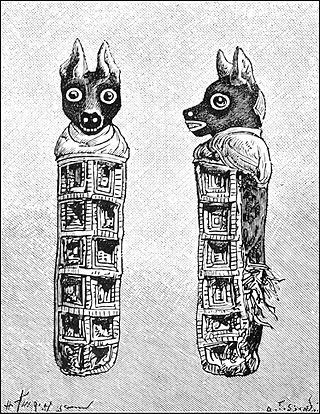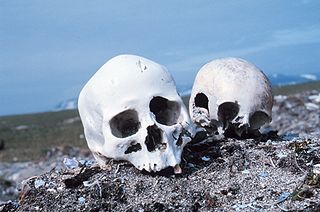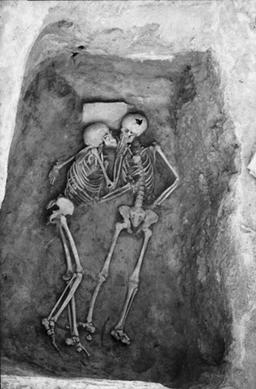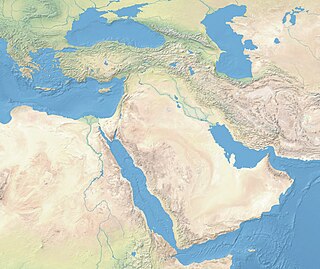
Zooarchaeology, also known as faunal analysis, is a branch of archaeology that studies remains of animals from archaeological sites. Faunal remains are the items left behind when an animal dies. These include bones, shells, hair, chitin, scales, hides, proteins and DNA. Of these items, bones and shells are the ones that occur most frequently at archaeological sites where faunal remains can be found. Most of the time, a majority of these faunal remains do not survive. They often decompose or break because of various circumstances. This can cause difficulties in identifying the remains and interpreting their significance.
The human skeleton is the internal framework of the human body. It is composed of around 270 bones at birth – this total decreases to around 206 bones by adulthood after some bones get fused together. The bone mass in the skeleton makes up about 14% of the total body weight and reaches maximum mass between the ages of 25 and 30. The human skeleton can be divided into the axial skeleton and the appendicular skeleton. The axial skeleton is formed by the vertebral column, the rib cage, the skull and other associated bones. The appendicular skeleton, which is attached to the axial skeleton, is formed by the shoulder girdle, the pelvic girdle and the bones of the upper and lower limbs.

Anthropometry refers to the measurement of the human individual. An early tool of physical anthropology, it has been used for identification, for the purposes of understanding human physical variation, in paleoanthropology and in various attempts to correlate physical with racial and psychological traits. Anthropometry involves the systematic measurement of the physical properties of the human body, primarily dimensional descriptors of body size and shape. Since commonly used methods and approaches in analysing living standards were not helpful enough, the anthropometric history became very useful for historians in answering questions that interested them.

Forensic anthropology is the application of the anatomical science of anthropology and its various subfields, including forensic archaeology and forensic taphonomy, in a legal setting. A forensic anthropologist can assist in the identification of deceased individuals whose remains are decomposed, burned, mutilated or otherwise unrecognizable, as might happen in a plane crash. Forensic anthropologists are also instrumental in the investigation and documentation of genocide and mass graves. Along with forensic pathologists, forensic dentists, and homicide investigators, forensic anthropologists commonly testify in court as expert witnesses. Using physical markers present on a skeleton, a forensic anthropologist can potentially determine a person's age, sex, stature, and race. In addition to identifying physical characteristics of the individual, forensic anthropologists can use skeletal abnormalities to potentially determine cause of death, past trauma such as broken bones or medical procedures, as well as diseases such as bone cancer.
Osteology is the scientific study of bones, practised by osteologists. A subdiscipline of anatomy, anthropology, and paleontology, osteology is the detailed study of the structure of bones, skeletal elements, teeth, microbone morphology, function, disease, pathology, the process of ossification, and the resistance and hardness of bones (biophysics).
The term bioarchaeology has been attributed to British archaeologist Grahame Clark who, in 1972, defined it as the study of animal and human bones from archaeological sites. Redefined in 1977 by Jane Buikstra, bioarchaeology in the United States now refers to the scientific study of human remains from archaeological sites, a discipline known in other countries as osteoarchaeology, osteology or palaeo-osteology. Compared to bioarchaeology, osteoarchaeology is the scientific study that solely focus on the human skeleton. The human skeleton is used to tell us about health, lifestyle, diet, mortality and physique of the past. Furthermore, palaeo-osteology is simple the study of ancient bones.
The Robert J. Terry Anatomical Skeletal Collection is a collection of some 1,728 human skeletons held by the Department of Anthropology of the National Museum of Natural History of the Smithsonian Institution, Washington, D.C., United States.
In disciplines including forensic anthropology, bioarchaeology, osteoarchaeology and zooarchaeology Minimum number of individuals, or MNI, refers to the fewest possible number of people or animals in a skeletal assemblage. It is used to determine an estimate of how many people or animals are present in a cluster of bones.
Post-excavation analysis constitutes processes that are used to study archaeological materials after an excavation is completed. Since the advent of "New Archaeology" in the 1960s, the use of scientific techniques in archaeology has grown in importance. This trend is directly reflected in the increasing application of the scientific method to post-excavation analysis. The first step in post-excavation analysis should be to determine what one is trying to find out and what techniques can be used to provide answers. Techniques chosen will ultimately depend on what type of artifact(s) one wishes to study. This article outlines processes for analyzing different artifact classes and describes popular techniques used to analyze each class of artifact. Keep in mind that archaeologists frequently alter or add techniques in the process of analysis as observations can alter original research questions.
The following outline is provided as an overview of and topical guide to forensic science:
FORDISC is a software program created by Stephen Ousley and Richard Jantz. It is designed to help forensic anthropologists investigate the identity of a deceased person by providing estimates of the person's size, ethnicity, and biological sex based on the osteological material recovered.

Skeletonization is the state of a dead organism after undergoing decomposition. Skeletonization refers to the final stage of decomposition, during which the last vestiges of the soft tissues of a corpse or carcass have decayed or dried to the point that the skeleton is exposed. By the end of the skeletonization process, all soft tissue will have been eliminated, leaving only disarticulated bones.

Odontometrics is the measurement and study of tooth size. It is used in biological anthropology and bioarchaeology to study human phenotypic variation. The rationale for use is similar to that of the study of dentition, the structure and arrangement of teeth. There are a number of features that can be observed in human teeth through the use of odontometrics.
Richard L. Jantz is an American anthropologist. He served as the director of the University of Tennessee Anthropological Research Facility from 1998–2011 and he is the current Professor Emeritus of the Department of Anthropology at the University of Tennessee, Knoxville. His research focuses primarily on forensic anthropology, skeletal biology, dermatoglyphics, anthropometry, anthropological genetics, and human variation, as well as developing computerized databases in these areas which aid in anthropological research. The author of over a hundred journal articles and other publications, his research has helped lead and shape the field of physical and forensic anthropology for many years.
The Phenice method is a technique of determining the sex of a human skeleton from the innominate pelvis. In the procedure, sex is determined based on three features: the ventral arc, the subpubic concavity, and the medial aspect of the ischio-pubic ramus. As a non-metric absolute method, it relies on the recognition of discrete male and female traits. This makes the method objective, easily performable, and relatively quick. It is considered highly accurate, up to 96%, owing to the distinct biological differences between male and female anatomy in the pelvis, making it a highly useful method for those determining the sex of a skeleton.

The Hasanlu Lovers are a pair of human remains found at the Teppe Hasanlu archaeological site, located in the Naqadeh in the West Azerbaijan Province of Iran. Around 800 BCE, the city of Hasanlu, located in north-western Iran, was destroyed by an unknown invader. Inhabitants were slain and left where they fell. In 1973, the lovers were discovered by a team of archaeologists from the University of Pennsylvania led by Robert H. Dyson.

The study of geometric morphometrics in anthropology has made a major impact on the field of morphometrics by aiding in some of the technological and methodological advancements. Geometric morphometrics is an approach that studies shape using Cartesian landmark and semilandmark coordinates that are capable of capturing morphologically distinct shape variables. The landmarks can be analyzed using various statistical techniques separate from size, position, and orientation so that the only variables being observed are based on morphology. Geometric morphometrics is used to observe variation in numerous formats, especially those pertaining to evolutionary and biological processes, which can be used to help explore the answers to a lot of questions in physical anthropology. Geometric morphometrics is part of a larger subfield in anthropology, which has more recently been named virtual anthropology. Virtual anthropology looks at virtual morphology, the use of virtual copies of specimens to perform various quantitative analyses on shape and form...

CranID was created in 1992 by anthropologist Richard Wright of the University of Sydney to infer the probable geographic origin of unknown crania that are found in archaeological, forensic and repatriation cases. Wright created the program to establish uniformity in cranial morphology based on the assumption that there is a high correlation between geographical location and cranial morphology. This was the first standardized program to evaluate the similarity and dissimilarity of cranial morphological characteristics of an unknown cranium and the database.
Mortuary archaeology is the study of human remains in their archaeological context. This is a known sub-field of bioarchaeology, which is a field that focuses on gathering important information based on the skeleton of an individual. Bioarchaeology stems from the practice of human osteology which is the anatomical study of skeletal remains. Mortuary archaeology, as well as the overarching field it resides in, aims to generate an understanding of disease, migration, health, nutrition, gender, status, and kinship among past populations. Ultimately, these topics help to produce a picture of the daily lives of past individuals. Mortuary archaeologists draw upon the humanities, as well as social and hard sciences to have a full understanding of the individual.

Near Eastern bioarchaeology covers the study of human skeletal remains from archaeological sites in Cyprus, Egypt, Levantine coast, Jordan, Turkey, Iran, Saudi Arabia, Qatar, Kuwait, Bahrain, United Arab Emirates, Oman, and Yemen.









